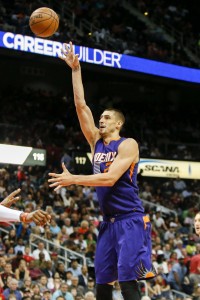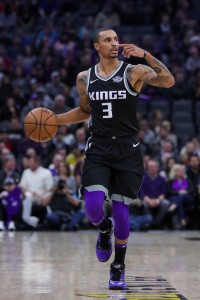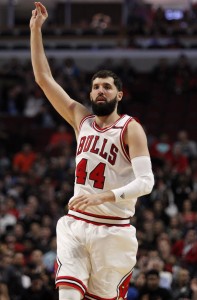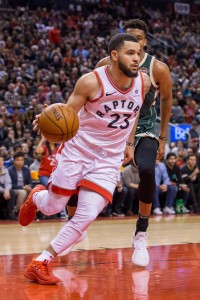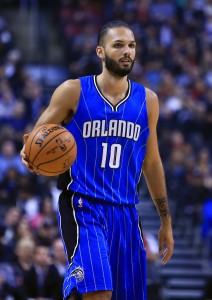The NBA trade deadline is just two and a half weeks away, and there’s no shortage of players around the league who could change teams. With that in mind, we’re taking a closer look at some of those top trade candidates, breaking them down by division.
While our focus will be primarily on teams expected to be sellers at the deadline, our lists may also include some players on contenders who could be used as trade chips when those teams look to make upgrades.
So far, we’ve covered the Southeast and Southwest. We’re examining the Atlantic Division today, so let’s dive in and identify seven players who could be on the move on or before February 8…
 Courtney Lee, G/F (Knicks): Lee’s cap hit for this season is $11.75MM, and it will jump to $12MM+ for the following two seasons. That’s not great, especially since he’s already 32 years old, but there are many players with similar skill sets around the NBA who cost more. And many of those more expensive players aren’t knocking down shots as effectively as Lee is — his 13.6 PPG and .434 3PT% are career bests, and he has been the league’s best free throw shooter (.965 FT%). If the Knicks‘ recent slide continues and the club falls further out of the playoff picture in the East, Lee looks like a prime trade candidate — expensive enough that clearing his contract from the books would help the Knicks in the long term, but affordable and productive enough that he’d draw interest from contenders.
Courtney Lee, G/F (Knicks): Lee’s cap hit for this season is $11.75MM, and it will jump to $12MM+ for the following two seasons. That’s not great, especially since he’s already 32 years old, but there are many players with similar skill sets around the NBA who cost more. And many of those more expensive players aren’t knocking down shots as effectively as Lee is — his 13.6 PPG and .434 3PT% are career bests, and he has been the league’s best free throw shooter (.965 FT%). If the Knicks‘ recent slide continues and the club falls further out of the playoff picture in the East, Lee looks like a prime trade candidate — expensive enough that clearing his contract from the books would help the Knicks in the long term, but affordable and productive enough that he’d draw interest from contenders.- Willy Hernangomez, C (Knicks): After a promising rookie campaign in 2016/17, Hernangomez has been turned into a benchwarmer this season due to New York’s logjam at center. While the Carmelo Anthony trade has turned out well for the Knicks as a team, the arrival of Enes Kanter in that deal has reduced Hernangomez’s role significantly, and the second-year big man would likely welcome a deal if it means he’ll see more minutes. The Knicks have reportedly received some calls on Hernangomez, but the former second-rounder is still just 23 years old and is on a very team-friendly deal. In other words, Steve Mills and Scott Perry aren’t just going to give him away.
- Kyle O’Quinn, C (Knicks): Rather than moving Hernangomez, the Knicks would probably like to find a taker for O’Quinn, who is a little older (28 in March) and a little more expensive ($4.09MM cap hit). O’Quinn doesn’t have Hernangomez’s upside, but the veteran center is posting career highs in several categories, including PPG (6.9), RPG (5.8), and FG% (.596). His $4.26MM player option for 2018/19 won’t appeal to clubs looking to keep their books as clean as possible next season, but it may not be a deal-breaker for some potential suitors. O’Quinn isn’t the answer for a team seeking an impact player in the middle, but he could be a decent investment for a team that just needs a little more depth up front.
- DeMarre Carroll, F (Nets): Carroll’s contract was viewed as so toxic during the 2017 offseason that the Raptors had to accept Justin Hamilton‘s unwanted contract and attach a first-round pick and a second-round pick to get the Nets to take it on. With just a year and a half now left on Carroll’s deal, it looks a little more palatable these days, especially since the veteran forward has been more effective in Brooklyn than he ever was in Toronto. Carroll is averaging career bests in PPG (13.0) and RPG (6.8), and while his shooting line (.409/.346/.773) still probably isn’t as high as the Nets would like, the 31-year-old has been a solid rotation player this season. His cap hit ($14.8MM) may make it difficult to deal him unless the Nets take back another undesirable contract, but Carroll’s trade value isn’t nearly as negative as it was just six months ago.
- Amir Johnson, F/C (Sixers): The Sixers‘ unusual 2017 free agent strategy saw the team overpay a pair of veterans to avoid having to commit to them for more than one year. The 76ers are getting what they hoped for from sharpshooter J.J. Redick, who is once again knocking down more than 40% of his three-point attempts, but Johnson has been somewhat underwhelming. With multiple options ahead of him at both power forward and center, Johnson is scraping out minutes where he can, but his 15.5 minutes per game are the least he has played since 2008/09. While Philadelphia presumably values Johnson’s veteran leadership in the locker room, his $11MM expiring contract would make sense as a trade chip if the club looks to make a move at the deadline.
- Jonas Valanciunas, C (Raptors): Valanciunas’ situation is similar to the one Ryan Anderson finds himself in for the Rockets, which we discussed last week. Both players are on lucrative contracts despite being unplayable against certain lineups — they were also both frequently mentioned in offseason trade rumors as their teams explored upgrades. As we noted when we discussed Anderson, once he stayed put through the offseason, he became less likely to be moved during the season. That’s also the case for Valanciunas, who continues to start for the Raptors despite averaging a career-low 21.0 MPG. If Toronto makes a deadline splash, Valanciunas looks like the most logical outgoing piece, but I’m not counting on that splash.
- The Celtics’ $8.4MM disabled player exception: It’s almost certainly cheating to include the Celtics‘ DPE here in place of a player, but the fact is that if Boston makes a deal, it seems more likely to involve this exception than any one player. Only three Celtics players – Kyrie Irving, Al Horford, and Gordon Hayward – are earning more than the $8.4MM this disabled player exception is worth, and those three players are extremely unlikely to be moved at the deadline. The Celtics also still have nearly $10MM in breathing room below the luxury tax line, meaning the team can afford to use its DPE to take on a player without sending out any salary in return. The fact that the DPE can only be used on a player with an expiring contract limits Boston’s options somewhat, but the team would still probably rather use the exception than surrender a rotation player or two in a trade.
Here are a few more potential Atlantic trade candidates to monitor:
- Spencer Dinwiddie, PG (Nets): Dinwiddie has been a revelation for the Nets and he’s on a minimum salary contract through 2018/19. The club could sell high on him, with D’Angelo Russell penciled in as the point guard of the future, but I’d still be somewhat surprised to see him moved.
- Joe Harris, F (Nets): Another sell-high candidate for Brooklyn, Harris has made 38.7% of his three-point attempts with the Nets and will be an unrestricted free agent this summer.
- Joakim Noah, C (Knicks): The Knicks would certainly rather move Noah than either of the two centers listed above, but his contract will make it virtually impossible.
- Jerryd Bayless, G (Sixers): While Bayless has been a solid rotation piece for the Sixers, getting his $8.58MM salary for 2018/19 off the books might be a smart long-term play.
- Lucas Nogueira, C (Raptors): Nogueira has fallen behind Jakob Poeltl on the Raptors‘ depth chart and will be a restricted free agent this summer. If another team wants to roll the dice on him, he could probably be had.
- Bruno Caboclo, F (Raptors): The same goes for Caboclo, a former first-round pick and a 2018 RFA-to-be who hasn’t developed like the Raptors hoped.
Photo courtesy of USA Today Sports Images.
